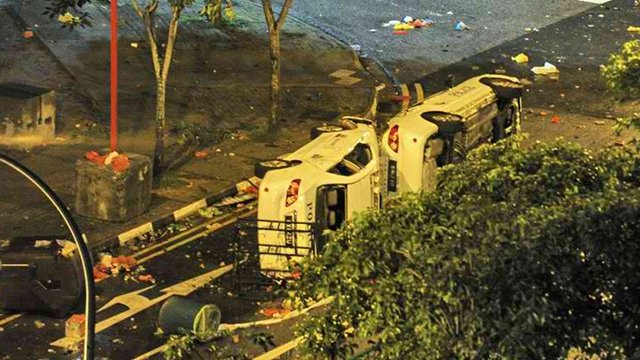SUMMARY
This is AI generated summarization, which may have errors. For context, always refer to the full article.

SINGAPORE – A riot by South Asian laborers has forced Singapore to take a fresh look at how it deals with the presence of nearly a million low-paid foreign workers in the wealthy city-state.
An estimated 400 workers went on the rampage on December 8 in a district known as Little India, injuring 39 people, including police officers, and destroying 25 vehicles.
The riot – the first in more than 40 years in the country – erupted after an Indian man was killed by a bus in an area where tens of thousands of workers converge at weekends.
Prime Minister Lee Hsien Loong has ordered an investigation into the cause of the violence as well as a review of measures to manage areas where foreign workers congregate.
Police have questioned nearly 4,000 workers and filed charges against at least 33 Indian nationals over the riot.
“We need the foreign workers,” Lee said Thursday, December 12, referring to criticism from some Singaporeans who see them as a problem.
“If we didn’t have them, we would not be able to achieve our housing plans, or our public transport plans, and Singaporeans would be severely affected.”
Singapore has a total population of 5.4 million, but only 3.84 million are citizens and permanent residents.
Out of the foreign population of 1.55 million, about 700,000 are work-permit holders employed in construction and other sectors shunned by Singaporeans, with more than 200,000 others working as domestics.
Latest available official data showed that resident foreigners and foreign companies contributed a total of 44% to Singapore’s gross domestic product (GDP) of Sg$334.1 billion ($266 billion) in 2011. Its GDP stood at Sg$345.6 billion in 2012.
Eugene Tan, an associate law professor at the Singapore Management University, said it was “now a bigger challenge to maintain the large foreign workforce”.
Tan, a social commentator who is also an appointed member of parliament, said: “There will be public expectation to reduce further the number of foreign workers.”
The long-ruling People’s Action Party (PAP) has already faced intense public pressure over a foreign worker influx in recent years.
Immigration a ‘major election issue’
In the May 2011 general election, the PAP suffered its worst-ever performance after the large foreign presence became a hot issue.
Authorities have since been phasing in various measures to cap foreign worker inflows.
“Quite certainly, the next general election will see immigration being a major election issue,” Tan said.
Officials have so far characterized the riot, Singapore’s first since racial disturbances in 1969, as an isolated incident involving a drunken crowd in Little India.
Police have temporarily banned alcohol sales and consumption in the riot zone.
Shelley Thio, an activist with aid group Transient Workers Count Too (TWC2), said the suggestion that alcohol was the main cause of the violence was a “knee-jerk reaction”.
“You have expatriates of various ethnicities inebriated at the pubs and bars in town on weekend nights, but you don’t see them rioting on the streets,” she told Agence France-Presse.
“The answer to the riot shouldn’t be one that involves more oppressive or draconian measures that further hurts the dignity of migrant workers, but rather a thorough investigation of the deep, underlying factors,” she said.
According to TWC2, migrant workers in Singapore face a multitude of problems, including mistreatment by employers and poor living conditions.
The Little India riot occurred a year after a work stoppage by Chinese bus drivers demanding higher pay from a state-linked transport company, the first industrial strike in the island since 1986.
Bedbug-infested dormitories were among their gripes.
Most worker dormitories are located away from main residential areas, sharpening the workers’ separation from mainstream society.
The median pay of a construction worker is Sg$900 a month, according to official data, but many of them are heavily in debt to recruiters back home and their Singaporean partners.
Singapore has a per capita income of Sg$65,048, making it one of the richest societies in the world.
Despite their difficulties, migrant workers who spoke to Agence France-Presse said they still consider Singapore among the best places to work.
“It is not an easy life working in Singapore but at least we can earn more than in Malaysia or Dubai,” construction worker Chinnaiyah Maarimuthu, an Indian national from Tamil Nadu, told Agence France-Presse.
“I hope Singaporeans don’t discriminate against workers just because of this incident,” he said during a brief respite from work at the construction site of a hotel in the central business district.
“We are all here to earn some money to make life better for our families.” – Rappler.com
Add a comment
How does this make you feel?
There are no comments yet. Add your comment to start the conversation.